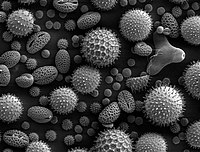
Photo from wikipedia
This work seeks to understand how the topography of a surface can be engineered to control secondary electron emission (SEE) for multipactor suppression. Two unique, semi-empirical models for the secondary… Click to show full abstract
This work seeks to understand how the topography of a surface can be engineered to control secondary electron emission (SEE) for multipactor suppression. Two unique, semi-empirical models for the secondary electron yield (SEY) of a micro-porous surface are derived and compared. The first model is based on a two-dimensional (2D) pore geometry. The second model is based on a three-dimensional (3D) pore geometry. The SEY of both models is shown to depend on two categories of surface parameters: chemistry and topography. An important parameter in these models is the probability of electron emissions to escape the surface pores. This probability is shown by both models to depend exclusively on the aspect ratio of the pore (the ratio of the pore height to the pore diameter). The increased accuracy of the 3D model (compared to the 2D model) results in lower electron escape probabilities with the greatest reductions occurring for aspect ratios less than two. In order to validate these models, a variety of micro-p...
Journal Title: Journal of Applied Physics
Year Published: 2017
Link to full text (if available)
Share on Social Media: Sign Up to like & get
recommendations!